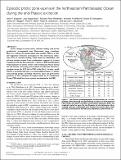| dc.contributor.author | Kasprak, A. H. | |
| dc.contributor.author | Price-Waldman, R. | |
| dc.contributor.author | Williford, K. H. | |
| dc.contributor.author | Schoepfer, S. D. | |
| dc.contributor.author | Haggart, J. W. | |
| dc.contributor.author | Ward, P. D. | |
| dc.contributor.author | Whiteside, J. H. | |
| dc.contributor.author | Sepulveda, Julio C | |
| dc.contributor.author | Summons, Roger E | |
| dc.date.accessioned | 2017-04-05T15:18:55Z | |
| dc.date.available | 2017-04-05T15:18:55Z | |
| dc.date.issued | 2015-02 | |
| dc.date.submitted | 2014-10 | |
| dc.identifier.issn | 0091-7613 | |
| dc.identifier.issn | 1943-2682 | |
| dc.identifier.uri | http://hdl.handle.net/1721.1/107847 | |
| dc.description.abstract | Severe changes in ocean redox, nutrient cycling, and marine productivity accompanied most Phanerozoic mass extinctions. However, evidence for marine photic zone euxinia (PZE) as a globally important extinction mechanism for the end-Triassic extinction (ETE) is currently lacking. Fossil molecular (biomarker) and nitrogen isotopic records from a sedimentary sequence in western Canada provide the first conclusive evidence of PZE and disrupted biogeochemistry in neritic waters of the Panthalassic Ocean during the end Triassic. Increasing water-column stratification and deoxygenation across the ETE led to PZE in the Early Jurassic, paralleled by a perturbed nitrogen cycle and ecological turnovers among noncalcifying groups, including eukaryotic algae and prokaryotic plankton. If such conditions developed widely in the Panthalassic Ocean, PZE might have been a potent mechanism for the ETE. | en_US |
| dc.description.sponsorship | National Science Foundation (U.S.) (Grant EAR-1147402) | en_US |
| dc.description.sponsorship | Exobiology Program (U.S.) (Grants NNX09AM88G and NNA08CN84A) | en_US |
| dc.description.sponsorship | American Association of Petroleum Geologists (Grant-In-Aid) | en_US |
| dc.description.sponsorship | Mary-Hill and Bevan M. French Fund for Impact Geology | en_US |
| dc.language.iso | en_US | |
| dc.publisher | Geological Society of America | en_US |
| dc.relation.isversionof | http://dx.doi.org/10.1130/g36371.1 | en_US |
| dc.rights | Creative Commons Attribution-Noncommercial-Share Alike | en_US |
| dc.rights.uri | http://creativecommons.org/licenses/by-nc-sa/4.0/ | en_US |
| dc.source | Other repository | en_US |
| dc.title | Episodic photic zone euxinia in the northeastern Panthalassic Ocean during the end-Triassic extinction | en_US |
| dc.type | Article | en_US |
| dc.identifier.citation | Kasprak, A. H. et al. “Episodic Photic Zone Euxinia in the Northeastern Panthalassic Ocean during the End-Triassic Extinction.” Geology 43.4 (2015): 307–310. | en_US |
| dc.contributor.department | Massachusetts Institute of Technology. Department of Earth, Atmospheric, and Planetary Sciences | en_US |
| dc.contributor.mitauthor | Sepulveda, Julio C | |
| dc.contributor.mitauthor | Summons, Roger E | |
| dc.relation.journal | Geology | en_US |
| dc.eprint.version | Author's final manuscript | en_US |
| dc.type.uri | http://purl.org/eprint/type/JournalArticle | en_US |
| eprint.status | http://purl.org/eprint/status/PeerReviewed | en_US |
| dspace.orderedauthors | Kasprak, A. H.; Sepulveda, J.; Price-Waldman, R.; Williford, K. H.; Schoepfer, S. D.; Haggart, J. W.; Ward, P. D.; Summons, R. E.; Whiteside, J. H. | en_US |
| dspace.embargo.terms | N | en_US |
| dc.identifier.orcid | https://orcid.org/0000-0002-7144-8537 | |
| mit.license | OPEN_ACCESS_POLICY | en_US |
